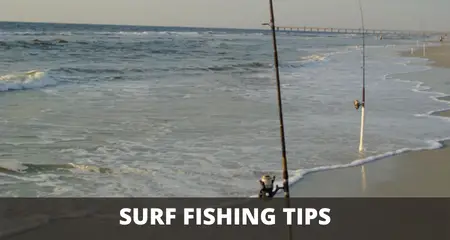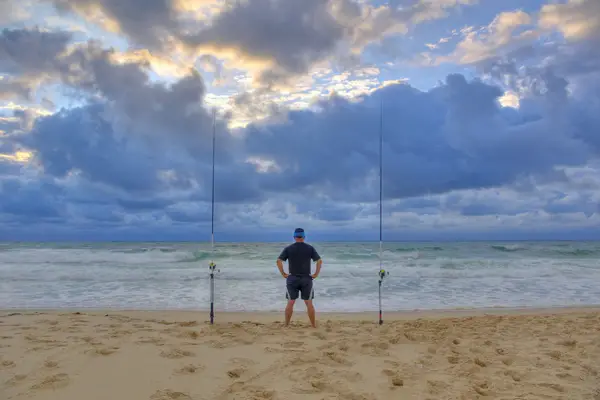Surf Fishing Tips (7 Tactics You Need To Know)
UPDATED 17 MAY 2023
by Robert Ceran
Most of the time, when I go to the beach, I already know what I’ll do. If puppy drum have been eating mullet, I’ll use drum rigs and the freshest mullet I can find.
Or, if big stripers at Oregon Inlet are eating live eels, that’s what I’ll put in my bait box.
But there are many days when I fish for whatever is around, and the gear I use is simple, but it works.

Choose a simple rig for locating fish
A standard two-hook bottom rig, which is sold everywhere along the Outer Banks, is one of my favorite rigs for searching for fish with bait.
They are made of light materials and work best for smaller fish, but surprisingly big fish have also been caught with them.
I finish these rigs with bronze or gold #2 or #3 long shank spinner blade hooks.
The color and movement of the spinners might give me an advantage, and the long shank style makes it easy to get the hook out of a fish’s mouth.
On each hook, I usually try a different bait, like small pieces of mullet or strips of squid.
How to use a moving rig to find fish
Most of the time, when I go surf fishing, I use pyramid sinkers because they hold the bottom well.
But if I could choose between a fishing rig that stayed in one place and one that moved slightly with the current or waves, I’d always choose the one that moved.
Fish are always on the move, and sometimes I want my rig to move, too, as long as the currents aren’t strong enough to blow it up or down the beach like tumbleweeds in the wind.
Choose the lightest sinker possible
I always use the lightest sinker I can get away with while still catching the bottom. If a four-ounce is holding like an anchor, I might go back to a three.
If the water is calm and there isn’t much wind or current, I often ditch the pyramids and use a flat pancake sinker instead.
Pancakes let the rig slide across the bottom, either being pulled by me or being pushed by the current and waves.
Move your bait actively for flounder
When fishing for flounder, I move the bait by sweeping the rod slowly and steadily or by twitching the rod tip.
This is a good way to catch flounder that stay in one place and wait for their prey to come by.

Long strips of squid that are hooked at one end so they move in the current kill flounder when they are set up in a way that lets the bait swim actively.
Similar to flounder, other fish also like to hit a moving target. Sea mullet often eat where the waves are breaking or where the water gets deeper at the edges of sandbars.
They might hang out in groups, and if you find one, you can catch more by going back to the spot where the last one bit.
Fish actively with a pancake weight
With a pancake weight, I can cast to the top of the bar and fish in the white water for a while. If nothing bites, I can bring the rig closer to me, off the edge of the bar.
The pancake weight doesn’t dig in like a pyramid or roll and twist my line like a round weight. It moves and lays flat, and I can work the rig a little bit with it.
If I’m lucky enough to catch some sea mullet, I can recast my bottom rig and slide it back to the same spot.
Try throwing lures in the surf
I like bait, but I also like to cast lures. One of my favorites is a small one-half or three-quarter-ounce Shorty Hopkins.
I’ll use an 8-foot spinning rod and reel with 8-pound test monofilament line and a light rod to fish with this small lure when the waves aren’t too big.
With the light line, the Hopkins lure will go a country mile, so I can cover a lot of ground from the outer bar to the drop-off at my feet.
If I’m fishing on a beach that’s empty, I’ll make a cast and then walk a few steps up or down the beach to cover more water.
Many fishermen think that shiny metal lures only catch bluefish, but I’ve used them to catch puppy drum, flounder, speckled trout, Spanish mackerel, striped bass, gray trout, and even one or two albacore.
Silver is my favorite color, but gold has also worked for me, especially when the water was dirty and I was fishing for puppy drum.
When finger mullet are running in the surf in September and October, a silver or gold lure can be deadly.
I like using a lure better than the other way to look for fish, since I like casting and reeling in more than holding a rod and waiting for a fish to bite, but some fish won’t hit a lure very often if you do that. Most of the time, bait is more effective for catching sea mullet, spot, and croakers.
What line should you use for surf fishing?
I use reels with mono or “super-braid” lines when fishing in the surf, but the “no-stretch” braids are best when I’m fishing with bait and want to feel even the smallest bite.
When sea mullet bite, they usually slam the bait, but sometimes they pick it up gently and swim toward the beach, which makes the line suddenly go slack.
Use a leader when fishing with lures
I usually add a 20-inch leader of 20-pound test monofilament or fluorocarbon to these lures to protect them from animals with sharp teeth.
Some anglers say that you shouldn’t use any extra gear when fishing with lures, which makes sense when the water is clear and the fish are picky.
My line and leader are connected by a tiny black #10 or #12 swivel, and the lure is attached by a small # 2 black finish snap.
The swivel keeps the line from twisting, and the snap lets me change the size and color of the lure without cutting the line and tying new knots.
I don’t think the size of the hardware is big enough to scare away fish who are interested in the bait.
Final remarks
After decades of fishing in the surf, I’ve found that I only use a few rigs and lures most of the time. It’s easy to understand why.
I couldn’t live without my simple two-hook bottom rigs and small Hopkins lures because they catch fish so reliably.
